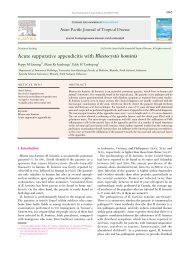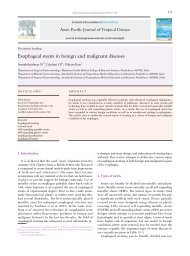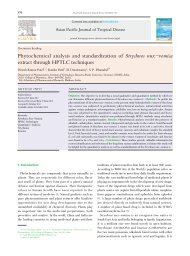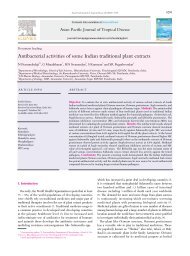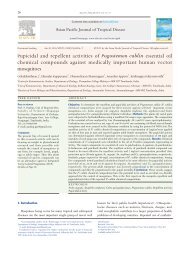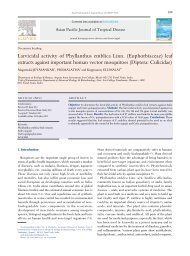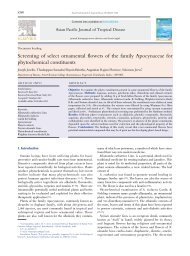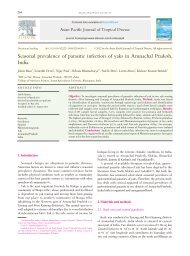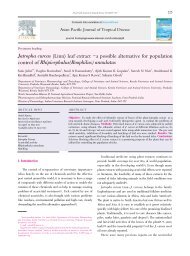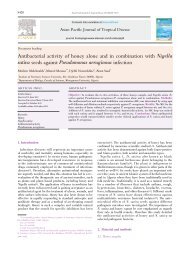Traditional use of medicinal plants as febrifuge by the ... - Apjtcm.com
Traditional use of medicinal plants as febrifuge by the ... - Apjtcm.com
Traditional use of medicinal plants as febrifuge by the ... - Apjtcm.com
Create successful ePaper yourself
Turn your PDF publications into a flip-book with our unique Google optimized e-Paper software.
S802<br />
Whole plant 8%<br />
Leaves 12%<br />
Seeds 8%<br />
Rhizomes<br />
Figure 1: Percentage distribution <strong>of</strong> plant parts utilized<br />
Infusion 4.50%<br />
Stem-bark 16%<br />
Powder 4.50%<br />
P<strong>as</strong>te 40.90%<br />
Fresh 4.50%<br />
4%<br />
Abhijit Dey et al./Asian Pacific Journal <strong>of</strong> Tropical Dise<strong>as</strong>e (2012)S800-S803<br />
Roots 52%<br />
Decoction 45.40%<br />
Figure 2: Percentage distribution <strong>of</strong> method <strong>of</strong> ethno<strong>medicinal</strong><br />
preparations.<br />
4. Discussion<br />
Several previously performed investigations support <strong>the</strong><br />
tribal <strong>use</strong> <strong>of</strong> <strong>medicinal</strong> <strong>plants</strong> <strong>as</strong> <strong>febrifuge</strong>. A large proportion<br />
<strong>of</strong> <strong>the</strong> <strong>plants</strong> (18 out <strong>of</strong> 22) were reported to be <strong>use</strong>d <strong>by</strong> <strong>the</strong><br />
traditional healers in <strong>the</strong> treatment <strong>of</strong> fever in <strong>the</strong> o<strong>the</strong>r<br />
parts <strong>of</strong> <strong>the</strong> world (Table 1). Interestingly, some <strong>of</strong> <strong>the</strong>se<br />
<strong>medicinal</strong> <strong>plants</strong> have been investigated pharmacologically<br />
for antipyretic properties. Table 1 also demonstrates <strong>the</strong><br />
pharmacological relevance <strong>of</strong> tribal usage <strong>of</strong> <strong>medicinal</strong><br />
botanicals against fever. Out <strong>of</strong> <strong>the</strong> 22 <strong>plants</strong>, 6 were reported<br />
<strong>as</strong> having antipyretic potential supported <strong>by</strong> laboratory<br />
experiments. Since, a huge percentage <strong>of</strong> people residing<br />
in <strong>the</strong> third world countries depend on traditional phytoremedy<br />
for <strong>the</strong>ir primary healthcare, this kind <strong>of</strong> correlation<br />
is always encouraging. Ethnobotany, in this way, serves <strong>as</strong><br />
<strong>the</strong> starting point which may lead to <strong>the</strong> novel herbal drug<br />
discovery p<strong>as</strong>sing through several pharmacological and<br />
clinical investigations.<br />
Purulia, with its typical topography, climate and location,<br />
is known to ho<strong>use</strong> a number <strong>of</strong> tribal <strong>com</strong>munities with<br />
diverse socio-cultural backgrounds. The ethnic groups are<br />
known to practice and inherit a rich knowledge <strong>of</strong> <strong>medicinal</strong><br />
botanicals. Rapid urbanization and loss <strong>of</strong> biodiversity are<br />
responsible for gradual vanishing <strong>of</strong> this folkloric heritage.<br />
Use <strong>of</strong> syn<strong>the</strong>tic drugs for quick relief, access to modern<br />
medicine, reluctance <strong>of</strong> younger generations to continue<br />
ancestral pr<strong>of</strong>ession <strong>as</strong> traditional healers are among <strong>the</strong><br />
o<strong>the</strong>r factors responsible for <strong>the</strong> decline. It is <strong>the</strong> high time<br />
to conserve and propagate <strong>the</strong> indigenous knowledge not<br />
only to alleviate human mortality and morbidity but to <strong>use</strong><br />
an alternative system <strong>of</strong> medicine which is cost effective and<br />
said to have lesser side effects.<br />
Conflict <strong>of</strong> interest statement<br />
We declare that we have no conflict <strong>of</strong> interest.<br />
References<br />
[1] Miller JS. The discovery <strong>of</strong> medicines from <strong>plants</strong>: A current<br />
biological perspective. Econ. Bot 2011; 65(4): 396-407.<br />
[2] Ansari JA, Inamdar NN. The promise <strong>of</strong> traditional medicines. Int<br />
J Pharmacol 2010; 6(6): 808-812.<br />
[3] Ajazuddin SS. Applications <strong>of</strong> novel drug delivery system for<br />
herbal formulations. Fitoterapia 2010. 81(7): 680-689.<br />
[4] H<strong>as</strong>ani-Ranjbar S, Nayebi N, Moradi L, Mehri A, Larijani B,<br />
Abdollahi M. The efficacy and safety <strong>of</strong> herbal medicines <strong>use</strong>d in<br />
<strong>the</strong> treatment <strong>of</strong> hyperlipidemia; a systematic review. Curr Pharm<br />
Des 2010; 16(26):2935-2947.<br />
[5] Farnsworth NR, Akerele O, Bingel AS, Soejarto DD, Guo Z.<br />
Medicinal <strong>plants</strong> in <strong>the</strong>rapy. Bull World Health Organ 1985; 63(6):<br />
965-981.<br />
[6] Dey A, Mukherjee S, D<strong>as</strong> T. In vitro Antibacterial activity <strong>of</strong><br />
n-Hexane fraction <strong>of</strong> methanolic extract <strong>of</strong> Plumeria rubra L.<br />
(Apocynaceae) stem bark. J Plant Sci 2011; 6(3): 135-142.<br />
[7] Mukherjee S, Dey A, D<strong>as</strong> T. In vitro antibacterial activity <strong>of</strong><br />
n-hexane fraction <strong>of</strong> methanolic extract <strong>of</strong> Alstonia scholaris<br />
L. R.Br. stem bark against some multidrug resistant human<br />
pathogenic bacteria. Eur J Med Plants 2012; 2(1): 1-10.<br />
[8] Dey A, De JN. Antifungal bryophytes: a possible role against<br />
human pathogens and in crop protection. Res J Bot 2011; 6(4): 129-<br />
140.<br />
[9] Pan L, Chai HB, Kinghorn AD. Discovery <strong>of</strong> new anticancer agents<br />
from higher <strong>plants</strong>. Front Biosci (Schol Ed) 2012; 4: 142-156.<br />
[10] Dey A, De JN. A survey <strong>of</strong> potential antiophidian botanicals from<br />
<strong>the</strong> Baruipur sub-division <strong>of</strong> <strong>the</strong> district South 24 Pargan<strong>as</strong>, West<br />
Bengal, India. Int J Med Aromatic Plants 2011; 1(3): 219-227.<br />
[11] Dey A, De JN. <strong>Traditional</strong> <strong>use</strong> <strong>of</strong> <strong>plants</strong> against snakebite in<br />
Indian subcontinent: A review <strong>of</strong> <strong>the</strong> recent literature. Afr J Tradit<br />
Complement Altern Med 2012; 9(1): 153-174.<br />
[12] Dey A, De JN. Rauvolfia serpentina (L). Benth. ex Kurz. A review.<br />
Asian J Plant Sci 2010; 9(6): 285-298.<br />
[13] Obidike IC, Emeje MO. Microencapsulation enhances <strong>the</strong><br />
anti-ulcerogenic properties <strong>of</strong> Entada africana leaf extract. J<br />
Ethnopharmacol 2011; 137(1): 553-561.<br />
[14] Eisenman SW, Poulev A, Struwe L, R<strong>as</strong>kin I, Ribnicky DM.<br />
Qualitative variation <strong>of</strong> anti-diabetic <strong>com</strong>pounds in different



